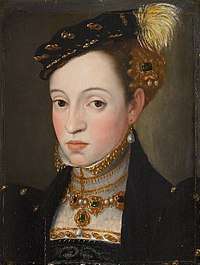Archduchess Magdalena of Austria
Archduchess Magdalena of Austria (German: Magdalena von Habsburg) (August 14, 1532 in Innsbruck – September 10, 1590 in Hall in Tirol)[1] was a member of the House of Habsburg, and the founder and first abbess of the convent in Hall in Tirol.

| Wikimedia Commons has media related to Archduchess Magdalene of Austria. |
Biography
Magdalena was the fourth daughter of fifteen children of Ferdinand I, Holy Roman Emperor, and his wife Anne of Bohemia and Hungary.
During his lifetime her father had expressed to Archduchess Magdalena and her younger sister Margaret the desire for them to remain unmarried and create a community of pious women. After her father's death in 1564, Magdalena took the vow of celibacy, and set out to found a "royal convent" in Hall in Tirol, where like-minded women - both aristocratic and bourgeois - could lead a reclusive, pious and God-fearing life under the supervision of the Jesuits.
Magdalena died in 1590 after a short sickness. She was buried in the Jesuit church in Hall in Tirol. In 1706, her remains were transferred to the convent church.
Ancestors
References
- Profile on Darlene's Family Genealogy
- Holland, Arthur William (1911). . In Chisholm, Hugh (ed.). Encyclopædia Britannica. 17 (11th ed.). Cambridge University Press.
- Wurzbach, Constantin, von, ed. (1861). . Biographisches Lexikon des Kaiserthums Oesterreich [Biographical Encyclopedia of the Austrian Empire] (in German). 7. p. 112 – via Wikisource.
- Chisholm, Hugh, ed. (1911). . Encyclopædia Britannica. 15 (11th ed.). Cambridge University Press.
- Poupardin, René (1911). . In Chisholm, Hugh (ed.). Encyclopædia Britannica. 5 (11th ed.). Cambridge University Press.
- Chisholm, Hugh, ed. (1911). . Encyclopædia Britannica. 10 (11th ed.). Cambridge University Press.
- Chisholm, Hugh, ed. (1911). . Encyclopædia Britannica. 14 (11th ed.). Cambridge University Press.
- Casimir IV, King of Poland at the Encyclopædia Britannica
- Priebatsch, Felix (1908), "Wladislaw II.", Allgemeine Deutsche Biographie (ADB) (in German), 54, Leipzig: Duncker & Humblot, pp. 688–696
- Wurzbach, Constantin, von, ed. (1860). . Biographisches Lexikon des Kaiserthums Oesterreich [Biographical Encyclopedia of the Austrian Empire] (in German). 6. p. 167 – via Wikisource.
- Boureau, Alain (1995). The Lord's First Night: The Myth of the Droit de Cuissage. Translated by Cochrane, Lydia G. The University of Chicago Press. p. 96.
- Noubel, P., ed. (1877). Revue de l'Agenais [Review of the Agenais]. 4. Société académique d'Agen. p. 497.